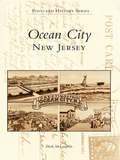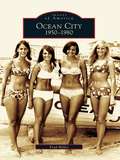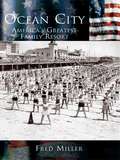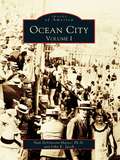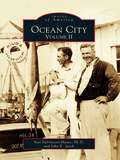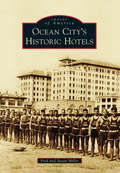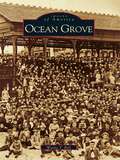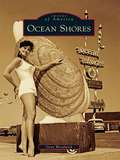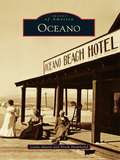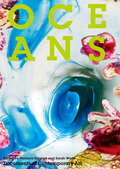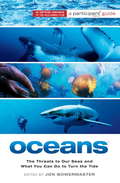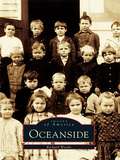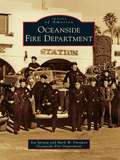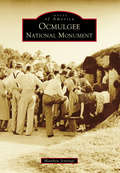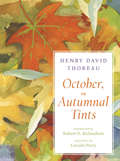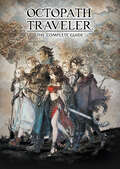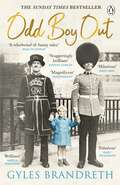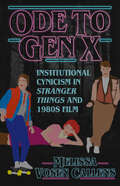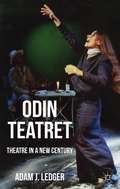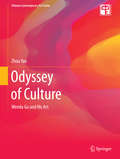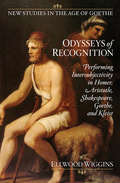- Table View
- List View
Ocean City, New Jersey (Postcard History)
by Mark MclaughlinFrom the early 1900s through the 1950s, the postcard was an extraordinarily popular means of communication, and many of the postcards produced during this "golden age" can today be considered works of art. Postcard photographers traveled the length and breadth of the nation snapping photographs of busy street scenes, documenting local landmarks, and assembling crowds of local children only too happy to pose for a picture. These images, printed as postcards and sold in general stores across the country, survive as telling reminders of an important era in America's history. This fascinating new history of Ocean City, New Jersey, showcases more than two hundred of the best vintage postcards available. Images in this collection date between 1879 and 1950.
Ocean City: 1950-1980 (Images of America)
by Fred MillerOcean City: 1950-1980 illustrates the growth and change of this seashore community founded in 1879 by a group of Methodist ministers. The venture was an immediate success, and the area quickly grew into a prosperous year-round community and a bustling summer resort. The Great Depression and World War II slowed this development, but by the beginning of the 1950s, the burgeoning economy and optimism in the country again encouraged people to enjoy family vacations. With the wide beaches, scenic boardwalk, three new major highways, and comfortable family atmosphere, Ocean City became a superb family destination.
Ocean City: America's Greatest Family Resort
by Fred MillerNestled along the New Jersey coastline and built to be one of the original seaside tourist destinations, Ocean City still sets the standard for resort living along the mid-Atlantic. What was once a whale-processing center in the 1700s emerged as a destination for sun and fun by drawing the biggest names and the classic American families of the early twentieth century. As our country's search for the ideal vacation grew, this 7-mile stretch of beach cultivated a rich history and a reputation as one of the most alluring communities on the East Coast.
Ocean City: Volume I (Images of America)
by Ph. D. Nan Devincent-Hayes John E. JacobOriginally the land of the Algonquian people, the barrier island on which Ocean City is now located, served as a protective wall for the mainland Delmarva peninsula. It was a somewhat remote area until five men, having formed the Atlantic Hotel Company Corporation, built the first lodging facility, and Ocean City as a coastal resort began to take root. From the cattle grazing in the mid-1800s to the few blocks of buildings constructed at the turn of the century, from the infamous storm of 1933 to the overwhelming growth of the 1940s, Ocean City has had a rich and vibrant history. This volume offers a historical perspective of Ocean City from its inception to 1946, a period when growth was steady but slow. Now boasting over eight million visitors annually, the area is Maryland's golden-haired child and its second-largest city during peak summer weekends when an average of 300,000 tourists arrive.
Ocean City: Volume II (Images of America)
by Ph. D. Nan Devincent-Hayes John E. JacobOcean City, Maryland's own seaside resort, has become so popular that it is almost too small--five square miles--to hold all its tourists. The last few decades have brought tremendous growth to the area in the form of both population and development. Bridges and tunnels have been built, high-rise hotels and condominiums have grown up, and amusements of all kinds have become available to the summertime crowds. In this second volume of Ocean City, images of beach life from the late 1940s to the present day capture the spirit of this popular vacation spot. From funnel cakes to Ferris wheels and deep-sea fishing to seasonal festivals, Ocean City, now a year-round retreat, has offered millions of visitors an endless variety of entertainment. Having survived destruction caused by storms, problems associated with the real estate boom, and the overwhelming surge of visitors who each summer crowd the boardwalk and Coastal Highway, this "small" town has matured over the last few decades into the jewel of Maryland's shore.
Ocean City’s Historic Hotels
by Susan Miller Fred MillerOcean City, New Jersey, was founded as a "Christian seaside resort" in 1879. Soon thereafter, it became a vibrant year-round community and a highly desirable summer retreat. Hotels were integral to the city's success. The most famous of these was the Flanders Hotel, which opened to much fanfare in 1923. It was built in the Spanish Mission Revival style and named after Belgium's Flanders Field; today, it is in the National Register of Historic Places. In addition to other stately hotels, such as the Brighton, the Biscayne, and the Bellevue, many smaller hotels and guesthouses, like Jernee Manor, the Castle Inn, Locksley Hall, and the Scarborough Inn, were also established. Ocean City's Historic Hotels features the rich architectural and recreational history of this New Jersey coastal town and its many hotels.
Ocean Grove (Images of America)
by Wayne T. BellIn 1869, a group of ministers and religious faithful established a permanent Methodist camp meeting community on the North Jersey shore. A state charter was issued one year later, and the community of Ocean Grove was born. Following the example set by other camp meetings, Ocean Grove became a center for religious revivals. The town continued to flourish as railroad and steamship lines transported passengers eager to escape the nearby crowded cities. For more than one hundred years, Ocean Grove has provided a retreat to those wishing to return to a life of religious renewal and recreation. Ocean Grove is a detailed look at the growth of this unique seaside community. Home to the largest aggregate of Victorian and early-twentieth-century structures in America, Ocean Grovecontinues to provide its visitors with a glimpse into the past. Ocean Grove has maintained its custom of holding summer camp meetings for over one hundred-thirty years. These annual revivals have attracted such notable speakers and guests as William Jennings Bryan, Booker T. Washington, and Presidents Grant and Roosevelt to the Great Auditorium. Since its conception, Ocean Grove has been home to an uncommon history, making Ocean Grove a treasure.
Ocean Liners: An Illustrated History
by Peter Newall&“A truly comprehensive publication, running the gamut from the first Atlantic sail-enhanced steamers to today&’s remaining handful of combi-liners.&” —Maritime Matters Before the advent of the jet age, ocean liners were the principal means of transport around the globe, and carried migrants and business people, soldiers and administrators, families, and lone travelers to every corner of the world. Though the ocean liner was born on the North Atlantic it soon spread to all the other oceans and in this new book the author addresses this huge global story. The account begins with Brunel&’s Great Eastern and the early Cunarders, but with the rise in nationalism and the growth in empires in the latter part of the 19th century, and the opening of the Suez Canal in 1869, the colonial powers of Spain, France, and Germany soon established shipping lines of their own, and transpacific routes were opened up by Japanese and American lines. The golden age between the two world wars witnessed huge growth in liner traffic to Africa, Australia and New Zealand, India, and the Far East, the French colonies, and the Dutch East and West Indies, but then, though there was a postwar revival, the breakup of empires and the arrival of mass air travel brought about the swan song of the liner. Employing more than 250 stunning photographs, the author describes not just the ships and routes, but interweaves the technical and design developments, covering engines, electric light, navigation and safety, and accommodation. A truly unique and evocative book for merchant ship enthusiasts and historians.
Ocean Shore Railroad
by Chris HunterWith one of the world's most scenic backdrops as a brilliant seascape for passengers, the Ocean Shore Railroad skirted northern California's coastline to service communities south of San Francisco for the first two decades of the 20th century. As impressive as it was idealistic, the line was held prisoner by natural forces that eventually took too much of a toll to keep its striking route churning. Today's Highway 1 traces the passage once paved with tracks, and points to the few remnants of one of California's most well-known excursion lines.
Ocean Shores
by Gene WoodwickOcean Shores was the newest city in Washington for nearly 40 years, but for centuries before it had been a place of permanent occupation and food gathering for Native American tribes and a place for sea otter hunters, pioneers, and settlers to reach the interior of the Olympic Peninsula. Before Ocean Shores, there was the dream of a town called Cedarville followed by the reality of Lone Tree with its post office and 200 residents. Point Brown Peninsula was a village of survival for Polynesian Kanakas, Finns living on the edge of society, migrant workers called Bluebills, and a Hooverville for Depression-era families. After World War II, when developers first conceived of creating a "Venice of the West," many said their dream would never last. However, in 1970, Ocean Shores became a city and today has entered its 50th year of development.
Oceano
by Linda Austin Norm HammondOceano is a California beach town between San Francisco and Los Angeles. Originally part of the Rancho El Pismo Mexican land grant of 1840, Oceano first appeared as a place name on a map in 1893 and was promoted as a beach resort soon after the Southern Pacific Railroad arrived in 1895. While most of these promotions failed during the Great Depression, the railroad depot continued as a shipping point for the area's agriculture. During this time, Oceano became a point of entry for the "Dunites," a group of artists, writers, and poets who once lived in the sand dunes south of town. Today Oceano is still the primary access and gateway to its state park beach and large sand dune complex. Many people come to enjoy the experience of driving on the beach, camping there, and venturing into the dunes on foot or by vehicle.
Oceans (Whitechapel: Documents of Contemporary Art)
by Sarah Wade Pandora SyperekOCEANS attends to the inextricable human and nonhuman agencies that affect and are affected by the sea and its running currents within contemporary art and visual culture.Oceans cover more than 70 percent of the Earth&’s surface, dividing and connecting humans, who carry saltwater in their blood, sweat and tears. They also represent a powerful nonhuman force, rising, flooding, heating and raging in unprecedented ways as the climate crisis unfolds. Artists have envisioned the sea as a sublime wilderness, home to mythical creatures and bizarre species, a source of life and death, a site of new beginnings and tragic endings, both wondrous and disastrous. From migration to melting ice caps, the sea is omnipresent in international news and politics, leaking into popular culture and proliferating in recent art and exhibitions. This anthology gathers artists and writers to address the ocean not only as a theme but as a major agent of artistic and curatorial methods.Artists surveyed includeBas Jan Ader, Eileen Agar, John Akomfrah, Heba Y. Amin, Shuvinai Ashoona, Betty Beaumont, Leopold & Rudolf Blaschka, Heidi Bucher, Marcus Coates, Tacita Dean, Chris Dobrowolski, Léuli Eshrāghi, Ellen Gallagher, Ayesha Hameed, Barbara Hepworth, Klara Hobza, Isuma, Brian Jungen, Tania Kovats, Sonia Levy, Armin Linke, Lani Maestro, Ana Mendieta, Kasia Molga, Eleanor Morgan, Wangechi Mutu, Saskia Olde Wolbers, Jean Painlevé and Geneviève Hamon, Allan Sekula, Shimabuku, Ahren Warner, Christine & Margaret Wertheim, Alberta WhittleWriters include Stacy Alaimo, Bergit Arends, Erika Balsom, Karen Barad, Rachel Carson, Mel Y. Chen, T.J. Demos, Marion Endt-Jones, Kodwo Eshun, Paul Gilroy, Stefano Harney, Epeli Hau&’ofa, Donna Haraway, Eva Hayward, Stefanie Hessler, Luce Irigaray, Zakiyyah Iman Jackson, Celina Jeffery, Melody Jue, Max Liboiron, Lana Lopesi, Chus Martínez, Jules Michelet, Fred Moten, Astrida Neimanis, Celeste Olalquiaga, Ralph Rugoff, John Ruskin, Marina Warner, Jan Verwoert
Oceans: The Threats to Our Seas and What You Can Do to Turn the Tide
by Participant Productions Jon BowermasterThis unique tie-in to the major motion picture Oceans--coming this April from Disney & National Geographic--explores the health of our oceans, and what we can do to improve it. More than 75 percent of the globe is covered by the oceans. It is sometimes difficult to understand why it is called Planet Earth rather than Planet Ocean. Since half the world's human population lives within a stone's throw of an ocean coastline, the oceans' health is increasingly important. Rich with resources and potential--as a source of renewable energy, new drugs, drinking water--for years we have treated them as both infinite and undamageable. But they are not. Over-fishing, climate change, pollution, acidification, and more have put the world's oceans and marine life at great risk. Oceans gathers some of the most insightful visionaries, explorers, and ocean lovers-- marine biologists, politicians, environmentalists, fishermen, sportsmen, deep divers, and more--in a unique anthology, in which each speaks to a unique aspect of our world's most dimly understood dimension.
Oceanside
by Richard WoodsOceanside is a close look at a community whose history begins with the history of Long Island. Captured in these images is the south shore town that was once one of the largest oyster-producing communities in the world. It is a place that, over the years, has attracted farmers, baymen, middle-class families, and millionaires. It has also drawn more than its share of visitors to St. Anthony's underground church, Beall's Zoo, the Roadside Rest, and Nathan's Famous Restaurant.
Oceanside Fire Department (Images of America)
by Mark W. Finstuen Stu Sprung Oceanside Fire DepartmentFor more than 120 years, the firefighters of the Oceanside Fire Department have had the privilege of serving one of Southern California's most active and popular coastal communities. Its firefighters are well known regionally as being highly skilled, capable, and aggressive when it comes to firefighting. This legacy has been handed down from Oceanside's first firefighters as they lived in the Wild West of the late 1800s, fighting blazes similar to those of today but with dungarees, cowboy boots, and nothing to guide them but instinct and bravery. Today a force of more than 100 modern, paramedic-trained firefighters protect over 180,000 Oceanside residents and visitors 24 hours a day, 365 days a year.
Ocmulgee National Monument
by Matthew JenningsPeople have called the land near the Ocmulgee River in present-day central Georgia home for a long time, perhaps as many as 17,000 years, and each successive group has left its mark on the landscape. Mississippian-era people erected the towering Great Temple Mound and other large earthworks around 1,000 years ago. In the late 17th century, Ocmulgee flourished as a center of trade between the Creek Indians and their English neighbors. In the 19th century, railroads did irreparable damage to the site in the name of progress and profit, slicing through it twice. Preservation efforts bore fruit in the 1930s, when Ocmulgee National Monument was created. Since then, people from all over the world have visited Ocmulgee. They come for many reasons, but they invariably leave with a reverence for the place and the people who built it hundreds of years ago and those who have maintained it in recent decades.
October, or Autumnal Tints
by Henry David Thoreau(From the Dust Jacket Flaps) "Originally delivered as a lecture shortly before the writer's own death, Henry David Thoreau's classic Autumnal Tints is an ode to autumn not as the season of death and decay, but of ripeness, fullness, and maturity. It is perhaps the best piece ever written on the subject of the fall color of the changing leaves. Thoreau hoped one day to turn it into an illustrated book called October, or Autumnal Tints. Thoreau's astute meditations are framed by a biographical essay by acclaimed scholar Robert D. Richardson that delves into the events and relationships influencing Thoreau's philosophy. Sensuous watercolors by Lincoln Perry bring to life the fall colors described so ecstatically by Thoreau, allowing longtime Thoreau fans and leaf-peepers alike to feel as though they are walking among the falling leaves alongside one of our best observers of the natural world."
Octopath Traveler: The Complete Guide
by Square EnixMaster Square Enix's critically acclaimed RPG Octopath Traveler with this comprehensive guide!Explore every corner of Orsterra with the help of this complete guide which includes insight and explanation of the main narrative as well as boss strategies for each of the games' eight protagonists! Dive deeper with detailed environment maps, subquest information, and beautiful illustrations that fully realize Octopath Traveler's HD-2D graphics with exclusive explanations and commentary from the development team.Dark Horse Books and Square Enix present a faithful localization of the original Japanese volume, offered in English for the first time! Whether you're a first-time player or looking to take your game to one hundred percent completion, this guide book is not to be missed!
Odd Boy Out: The ‘hilarious, eye-popping, unforgettable’ Sunday Times bestseller 2021
by Gyles BrandrethThe compelling, witty and remarkably honest autobiography from beloved star of Just a Minute, QI, Have I Got News For You and Celebrity GoggleboxTHE SUNDAY TIMES BESTSELLER'Hilarious, ribald, eye-popping, unforgettable, will make you laugh out loud' DAILY MAIL'Warm, witty, charming. A moving and very affectionate family history. An enthusiast for life' THE TIMES________Enter the world of Gyles Brandreth - broadcaster, actor, writer, former politician - as he takes us on an extraordinary journey into his past.From growing up in an apparently well-to-do but strapped-for-cash middle-class English family to his adventures in swinging London, Gyles encounters princes, presidents, pop stars and prime ministers, gets involved in everything from setting up Scrabble championships to examining Danish sex shops, and thrills us with countless tales of family, friends and acquaintances, both famous and infamous.Filled with incredible and sometimes shocking stories, Odd Boy Out is the story of Gyles Brandreth's fascinating life told with his unique wit and charm.________'Staggeringly brilliant, funny and touching, I loved it' JOANNA LUMLEY 'Light-hearted and dark events alike are described with his customary jaunty style, making them funny, moving an sometimes deeply shocking ' Sheila Hancock
Ode to Color: The Ten Essential Palettes for Living and Design
by Lori WeitznerInternationally renowned textile designer Lori Weitzner presents a novel, layered perspective on the use and significance of color in design and culture in this spectacular treasury illustrated with 225 full-color images.Ode to Color, a stunning anthology by renowned and award-winning textile and wallcovering designer Lori Weitzner, principal of Lori Weitzner Design, Inc., offers an immersive, sensual, and engaging journey in the world of color as it applies to culture, design, mood, and memory. Each of the ten chapters in this richly illustrated volume presents a distinct color world through an intimate and often kaleidoscopic perspective, a compilation of the numerous—and often shifting—associations and emotions we assign to a color or group of colors.Each chapter combines diverse imagery—evocative fine art and photography, environmental interiors, details of Weitzner’s gorgeous designs as well as her sketches and watercolors—with excerpts from literature and her own essays on a wide array of topics relating to the palette. The result is a fully sensory conveyance of each palette’s particular power as well as a consideration of its tangible and intangible connections, from its place in religion, pop culture, and commerce to the impact it has upon our decision making, our moods, and our tastes. While each chapter is unique in its approach to the ten worlds, with its mix of essays, prose and range of art, from a Technicolor Disney cartoon in Out Loud to David Bowie as Ziggy Stardust in Silverlight, each chapter includes: An introductory essay on a subject that characterizes the paletteA two-page photographer of an open drawer in Weitzner’s studio that she has arranged with various fabrics, skeins, and objects that, together, comprise the palette;An evocative two-page word collage that presents both color names and the words commonly associated with the palette;Design pointers that provide in-depth insight to working with color and to decorating with each palette throughout the home, from wall treatments to accessories. Spectacular and imaginative, this experiential volume will captivate, inspire, and inform a broad audience, including interior designers and decorators, architects, graphic and fine artists, and anyone interested in art, design, fashion, pop culture, and spiritual discovery. Sumptuous, beautifully designed, and filled with wondrous imagery and compelling stories and facts, it makes an inspiring and unusual gift for almost any occasion.
Ode to Gen X: Institutional Cynicism in Stranger Things and 1980s Film
by Melissa Vosen CallensEven for the casual viewer, the Netflix series Stranger Things will likely feel familiar, reminiscent of popular 1980s coming-of-age movies such as The Goonies, E.T. the Extra-Terrestrial, and Stand by Me. Throughout the series, nods to each movie are abundant. While Stranger Things and these classic 1980s films are all tales of childhood friendship and shared adventures, they are also narratives that reflect and shape the burgeoning cynicism of the 1980s. In Ode to Gen X: Institutional Cynicism in "Stranger Things" and 1980s Film, author Melissa Vosen Callens explores the parallels between iconic films featuring children and teenagers and the first three seasons of Stranger Things, a series about a group of young friends set in 1980s Indiana. The text moves beyond the (at times) non-sequitur 1980s Easter eggs to a common underlying narrative: Generation X’s growing distrust in American institutions. Despite Gen X’s cynicism toward both informal and formal institutions, viewers also see a more positive characteristic of Gen X in these films and series: Gen X’s fierce independence and ability to rebuild and redefine the family unit despite continued economic hardships. Vosen Callens demonstrates how Stranger Things draws on popular 1980s popular culture to pay tribute to Gen X’s evolving outlook on three key and interwoven American institutions: family, economy, and government.
Odin Teatret: Theatre in a New Century
by Adam J. LedgerFocusing on Odin Teatret's latest work, this discussion is updated by drawing on fresh research. The group's productions since 2000 are included and the book offers a reassessment of Odin's actor training. Its community work and legacy are discussed and Barba's intercultural practice is viewed alongside two major Theatrum Mundi productions.
Odyssey Works: Transformative Experiences for an Audience of One
by Rick Moody Abraham Burickson Ayden LerouxOdyssey Works infiltrates the life of one person at a time to create a customtailored, life-altering performance. It may last for one day or a few months and consists of experiences that blur the boundaries of life and art--is that subway mariachi band, used book of poetry, or meal with a new friend real or a part of the performance? Central to this book is their 2013 performance for Rick Moody, author of The Ice Storm. His Odyssey lasted four months and included a fake children's book, introducing the themes of his performance, and a cello concert in a Saskatchewan prairie (which Moody almost missed after being stopped at customs with, suspiciously, no idea why he was traveling to Canada). The book includes Moody's interviews with Odyssey Works, an original short story by Amy Hempel, and six proposals for a new theory of making art.
Odyssey of Culture
by Yan ZhouThis book is the first case study on Wenda Gu that systematically investigates the cultural and artistic context of his life and works, examining selected images of his artwork spanning from the late 1970s to the early 21st century. It is the first monograph to provide a comprehensive and profound study of a Chinese contemporary artist. In the 1980s, the School of Hermeneutics attempted to launch a discursive revolution. Vanguard artists believed that the visual art revolution was an integral part of the critique of culture because it tended to subvert and rebuild the cultural tradition at a discursive level. This book, using a case study on Wenda Gu as representative of Chinese avant-garde, investigates the centrality of culture in art, providing readers with insights on the origin, rationale and methodology of Chinese contemporary art.
Odysseys of Recognition: Performing Intersubjectivity in Homer, Aristotle, Shakespeare, Goethe, and Kleist (New Studies in the Age of Goethe)
by Ellwood WigginsLiterary recognition is a technical term for a climactic plot device. Odysseys of Recognition claims that interpersonal recognition is constituted by performance, and brings performance theory into dialogue with poetics, politics, and philosophy. By observing Odysseus figures from Homer to Kleist, Ellwood Wiggins offers an alternative to conventional intellectual histories that situate the invention of the interior self in modernity. Through strategic readings of Aristotle, this elegantly written, innovative study recovers an understanding of interpersonal recognition that has become strange and counterintuitive. Penelope in Homer’s Odyssey offers a model for agency in ethical knowledge that has a lot to teach us today. Early modern and eighteenth-century characters, meanwhile, discover themselves not deep within an impenetrable self, but in the interpersonal space between people in the world. Recognition, Wiggins contends, is the moment in which epistemology and ethics coincide: in which what we know becomes manifest in what we do. Published by Bucknell University Press. Distributed worldwide by Rutgers University Press.
